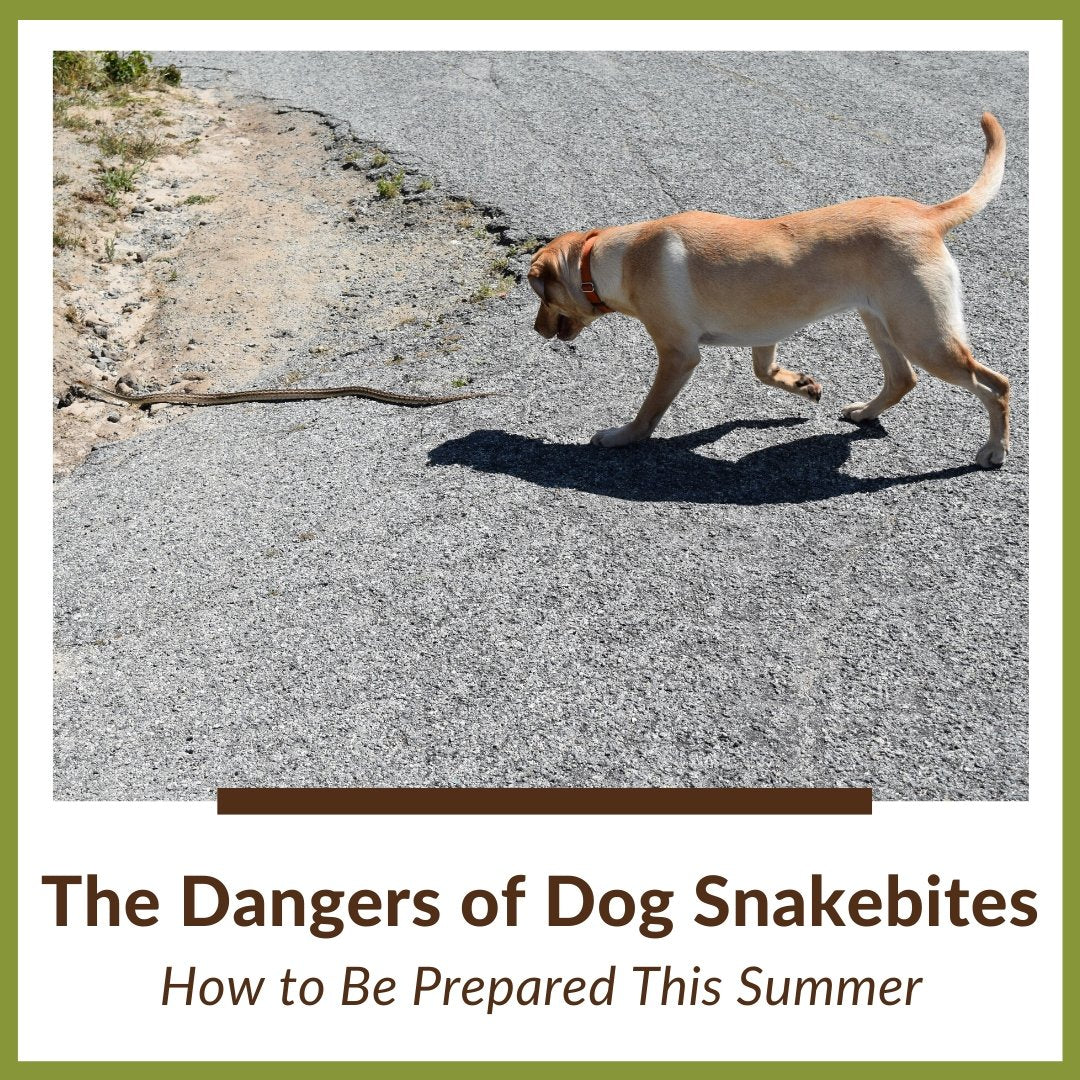
The Dangers of Snakebites in Dogs: How to Be Prepared This Summer
Share
It’s summertime, and you’re no doubt soaking up all the sun you can get with your pups, whether it’s in your backyard, on a regular walk locally, or on a hiking trail. What you might not be too aware of is how much snakes love summertime, too! And when pups stick their curious noses where they aren’t welcome, dangerous and scary situations can arise.

Snake bites are actually quite common in dogs. While there are no formal resources to provide specific data around snake bites and dogs, it is estimated that there could be more than 100,000 snakebites in dogs and cats annually, with a mortality rate between 1-30%. Obviously, every pet parent wants to avoid this situation, but how much do we know about snakes when it comes to keeping your pets safe? What kinds of snakes pose serious threats to your dog, and what can we do to provide and treat snakebites?
Different Snakes to Look Out For
In the United States, you can find 4 types of venomous snakes. Here’s what you should know about each one:Water Moccasins
Otherwise known as Cottonmouths, these snakes are found in southeastern regions extending as far as eastern Texas and usually found near swamps, ponds, marshes, and drainage ditches. One common issue with water moccasins is that they can be confused with nonvenomous snakes. And, unfortunately, Cottonmounts are actually quite aggressive. Their venom can prevent blood from clotting and coagulating, with results that can be serious or deadly. Envenomation can also lead to tissue and muscle damage, extremity loss, and more.
Copperheads
They might have the weakest venom, (thankfully!), but these snakes are some of the most ubiquitous with a wide geographical range. They also happen to be responsible for the most bites in humans, so you should be careful, too! Like water moccasins, their venom is hemotoxic. Their bites are extremely painful but rarely fatal.
Coral Snakes
These snakes are found in southern and coastal areas, but some species of Coral can be found elsewhere around North America. They have one of the most toxic venoms of any snake, containing a neurotoxin that leads to paralysis and respiratory failure for both humans and their pets. Additionally, the venom works slowly and won’t immediately appear to be as painful as other snakebites, making symptoms harder to catch right away. This is helpful information to know, but perhaps shouldn’t be too much cause for alarm: Coral snakes are fairly reclusive, and the rates for snakebites are low.
Rattlesnakes
Rattlesnakes are probably the most well-known venomous snake found in the US, and that’s because they can be found almost everywhere. Their bites are alarmingly common in humans and animals, too. They are most commonly found in the West and have a variety of habitats like trails, mountains, deserts, even beaches. While some rattlesnakes have hemotoxic venom, most have neurotoxic venom, posing the most serious hazards to humans and pets.
How to Prevent Snake Bites
It might be obvious, but needs to be said: the best way to prevent snake bites is to try and avoid snakes altogether! Whenever you’re out on a walk, keep your pooch leashed up close so that you can prevent him or her from getting into heavy brush, tall grass, woodpiles, or rock crevices where snakes can hide. Try and stay on trails that are more trafficked; in other words, well-worn so that you can see what lies ahead more clearly. If you and your pups are more courageous adventurers and want to explore off-leash, you might want to consider undergoing more formal training to avoid and treat snakebites.
If you have a yard, consider taking steps to prevent rattlesnakes from making a home there, especially if you have a shed or garage. Rattlesnakes are rodent-hunters, so consider having an extermination plan and installing below-ground fences if you don’t already have them. Be sure to keep your garages and sheds free of rodents, too, as snakes will seek these cooler environments when temperatures are high. Another thing to note is that snakebites in cats are rare. That might be because most domesticated cats stay indoors, so if you do have an outdoor cat, be sure to keep as close an eye as possible during the summertime or perhaps keep your kitty indoors more.
What to Do if your Dog is Bitten
The first thing you need to do if your dog is bitten is to stay calm. There are several steps you’ll need to take to ensure a safe recovery, so you’ll need your wits about you! Your pup also needs to remain calm and will follow your lead. If he sees you panic, chances are he will be very excitable.
Wash the bite with soap and water and keep your pet as immobilized as possible. Carry him if you can, and try to keep the area where he was bitten lower than his heart to slow the spread of venom. Even if you’re not sure what kind of snake bit him, venomous or not, you should call your veterinarian immediately. Remove anything restrictive that your pet might be wearing before swelling occurs, and never try to cut the wound or suck out the venom. This is a myth and will not work!
The faster you can get your pet to the veterinarian, the better. A quick response will increase his or her chance at survival and help ensure there won’t be as many complications during treatment. Your vet will typically begin IV fluids and administer medication to treat shock if applicable, and thanks to available veterinary medicine, most pets can recover with appropriate treatment. Still, snake bites can be fatal, so the time it takes you to get him into emergency care is the most crucial factor in his recovery.
Your pet’s recovery relies on a number of different factors. The size of both him and the snake, the location of the bite, and the response time. If treated promptly and appropriately, your pup may recover between 24 and 48 hours. However, some pets may take longer, especially if there has been damage to his muscle or tissue.
If you’re at home looking after a pet who has just undergone emergency care and is recovering, Homescape Pets has you covered! Especially with inflammatory conditions, our Calming Relief can help calm his or her discomfort and aches during recovery. With powerful fatty acids like Omega-6 and Omega-3, Calming Relief also promotes healthy organ function and immune system.
Are you following us on the ‘gram yet? Follow us at @HomescapePets! We’ve got more news coming your way, as well as important tips (like snakebite prevention!) to keep your pets safe, healthy, and happy.
